5 examples of ChatGPT used to improve code development

In recent years, using artificial intelligence and machine learning in software development has become increasingly prevalent. As a result, developers are turning to tools like OpenAI’s ChatGPT to streamline their work and improve their productivity. ChatGPT, a large language model trained by OpenAI, can assist developers in various tasks, from coding to documentation and testing, and this article will show you how.
ChatGPT is a significant language model developed by OpenAI that has proven to be a valuable tool in modern software development. It is an artificial intelligence (AI) system that uses natural language processing (NLP) and machine learning (ML) algorithms to understand human language and generate responses.
ChatGPT has been trained on a massive amount of text data from various sources, making it capable of generating high-quality text that is often indistinguishable from human-written content. This capability has made ChatGPT an invaluable tool for developers in several areas, including text generation for code snippets, automated bug fixing, chatbot for technical support, and generating documentation.
Five Examples of Developers Using ChatGPT
As a powerful language model, developers have used ChatGPT to build innovative applications across various industries. These applications range from chatbots and language translation tools to content creation and customer support solutions.
In this section, we will highlight five examples of developers using ChatGPT and explore the unique ways in which they have leveraged the model’s capabilities to solve complex problems and improve user experiences. These examples showcase the versatility and potential of ChatGPT as a tool for building intelligent applications that can revolutionize how we interact with technology.
Text Generation for Code Snippets
Generating code snippets is a critical task for developers, and ChatGPT can help them do it more efficiently. By inputting the desired functionality, ChatGPT can produce code snippets that can be easily integrated into the developer’s project.
ChatGPT has the potential to significantly improve the efficiency, productivity, and quality of ****software development by automating the process of generating code snippets based on natural language descriptions.
Live Example
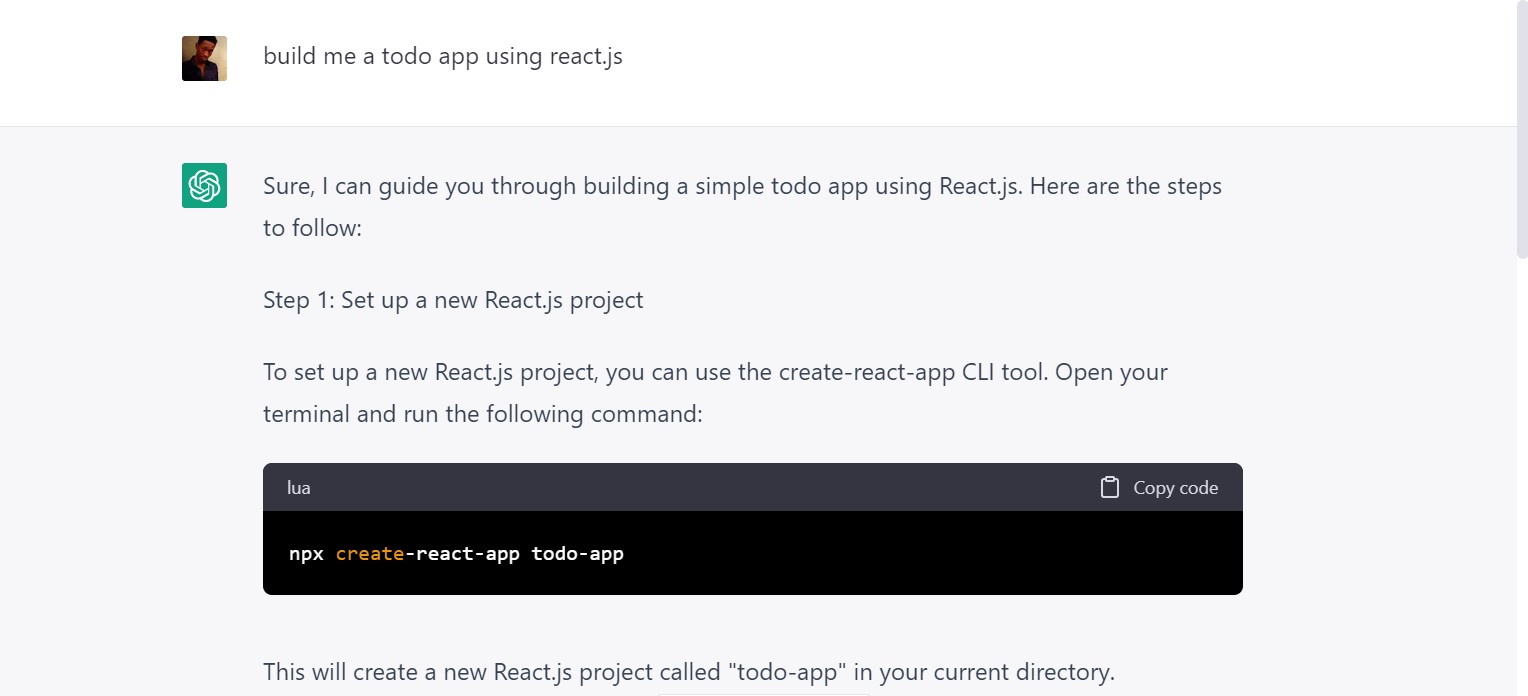

In the image above, chatGPT was prompted to build a todo app, and it did so with the exact Javascript framework(React). This level of intelligence offers several advantages, and they are:
- Time-saving: ChatGPT can automate generating code snippets, saving developers time and effort.
- Improved code quality: ChatGPT can help reduce errors in code generation, improving the overall code quality.
- Faster learning: ChatGPT can provide developers with suggestions for code snippets they may not have thought of, allowing them to explore different solutions to a problem and learn more quickly.
- Reduced cognitive load: ChatGPT can reduce the cognitive load on developers by automating the process of generating code snippets, allowing them to focus on more critical tasks.
- Code standardization: ChatGPT can help to standardize code snippets, ensuring that code is consistent across a project or organization.
Programming Language Transition
ChatGPT is an AI-based language model designed to understand and interpret a wide range of programming languages. This means it is not limited to a particular programming language and can seamlessly transition from one language to another.
For instance, let’s consider a scenario where a simple Todo app is built using vanilla JavaScript. In such a case, if you want to switch to React, a popular JavaScript library for building user interfaces, you would typically need to rewrite the entire application using React syntax. However, ChatGPT can simplify this process, and you can easily transition to React without writing a single line of code.
This is because ChatGPT is trained on a vast corpus of programming language syntax and can understand the underlying logic of the application. As a result, it can translate the existing JavaScript code to React syntax, facilitating a smooth transition.
Live Example I got a Todo application built with vanilla javascript from here, and I prompted ChatGPT to rewrite this same code in React; below are images illustrating this:
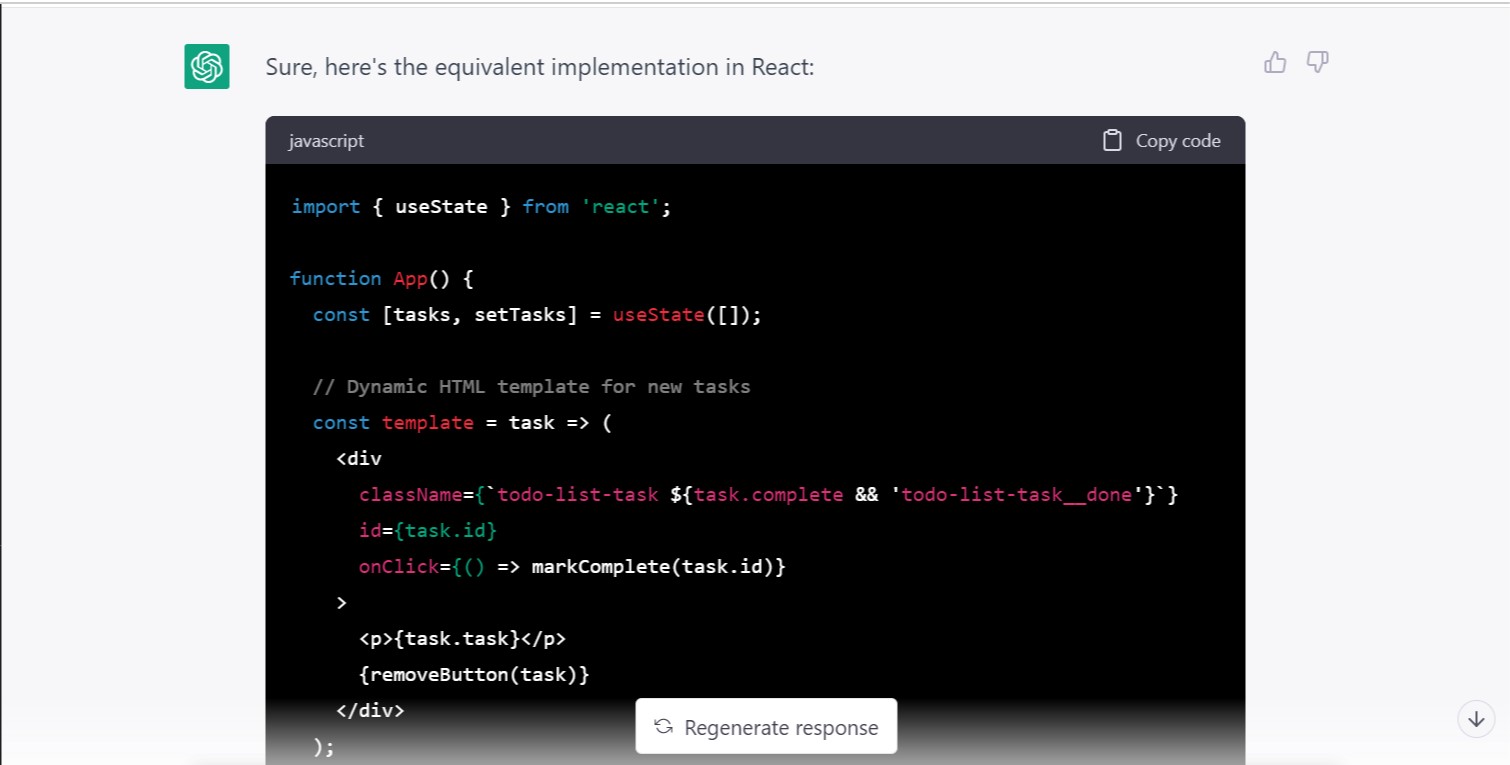
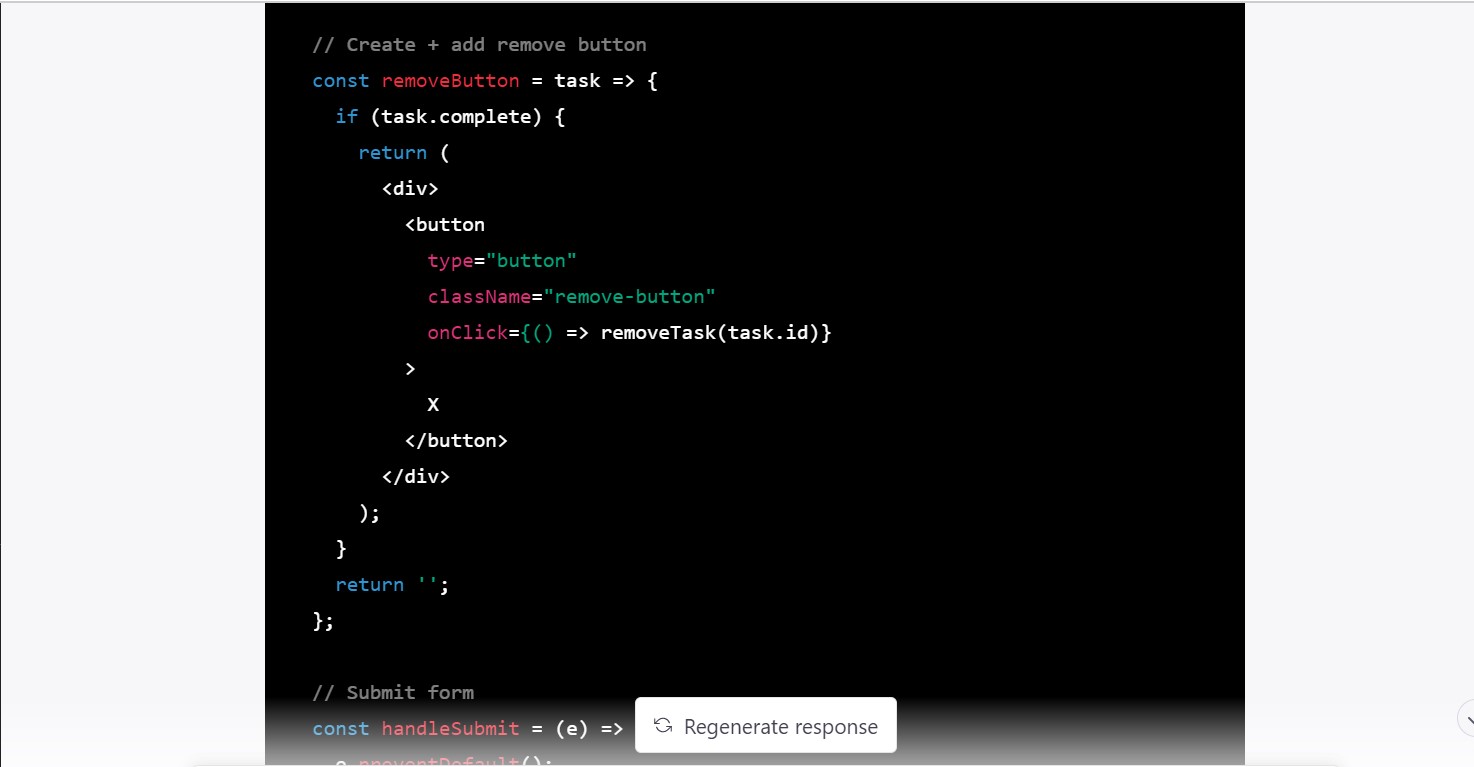
This capability of ChatGPT to transition between programming languages can save developers a significant amount of time and effort that would otherwise be spent on rewriting the entire application from scratch. Moreover, it can help developers explore and experiment with new languages without learning them from scratch, thereby enhancing their productivity and efficiency.
Code optimization
Code optimization improves code performance by reducing the execution time, memory usage, or other resources consumed by a program. ChatGPT, as an AI language model, can help developers optimize their code by analyzing it and providing suggestions on improving its performance.
Live Example: Before this section, we asked ChatGPT to help us transition a vanilla JavaScript code to ReactJS. Now, we are looking to optimize our application and are seeking ChatGPT’s assistance for suggestions. The images below show the recommendations provided by ChatGPT to help us optimize our application.
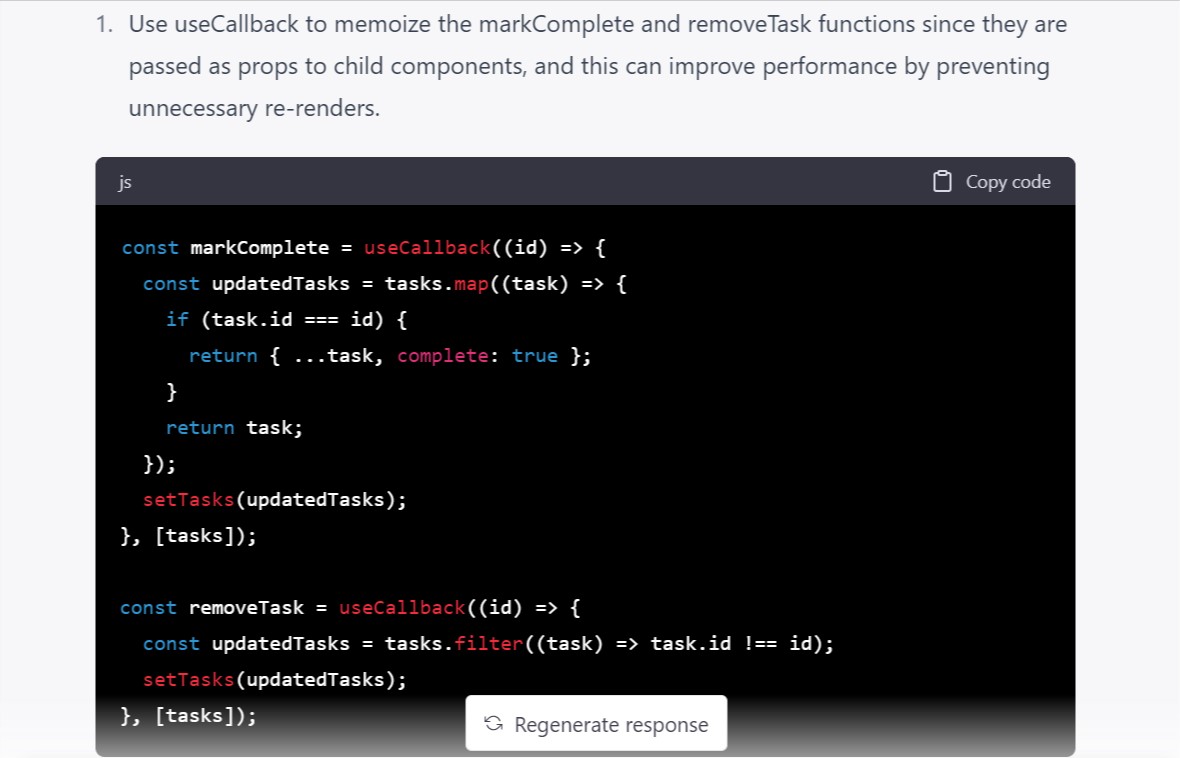
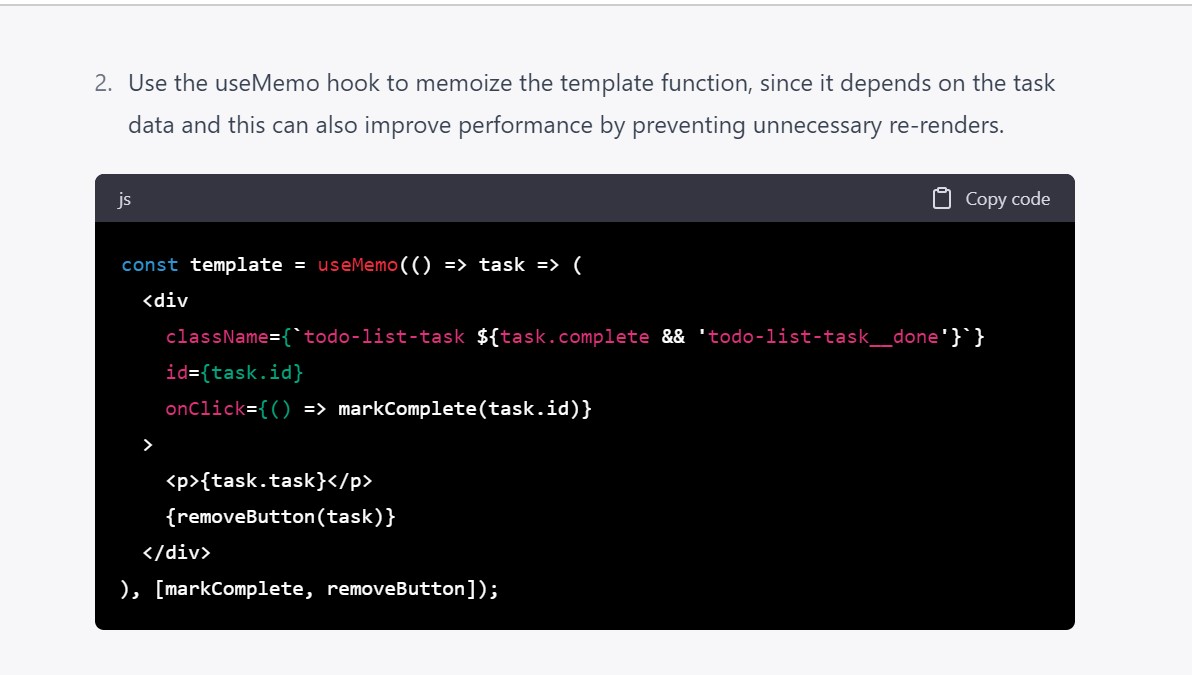

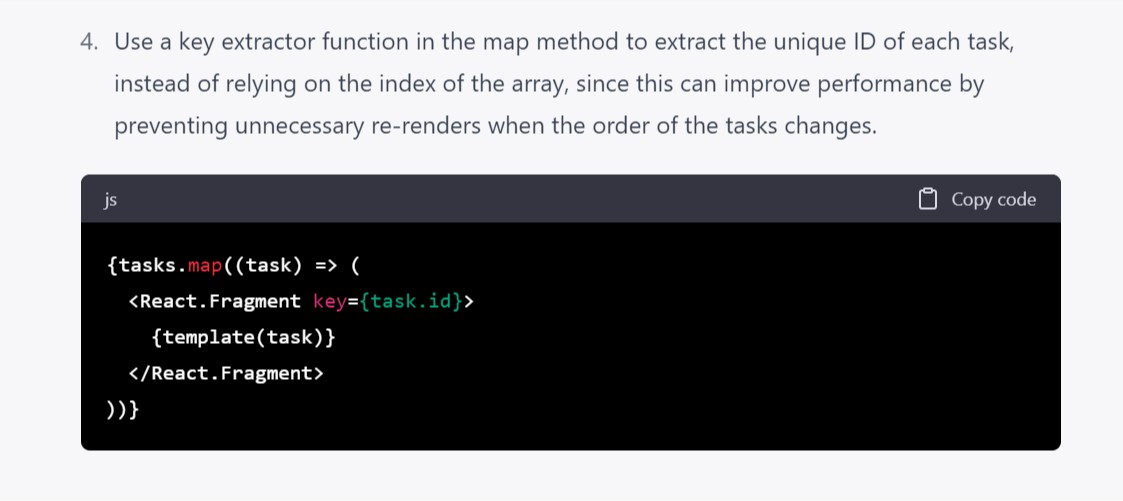
These optimization suggestions bring loads of advantages; below are the advantages they offer:
-
Faster performance: ChatGPT can analyze code quickly and accurately and provide suggestions for optimizing it in real time. This means that developers can improve the performance of their code more quickly than if they had to do it manually.
-
Improved code quality: ChatGPT can identify potential issues in code that might be slowing it down or causing errors. By addressing these issues, developers can improve the quality of their code and make it more reliable.
-
Better scalability: Code optimization is particularly important for applications that handle large amounts of data or users. By optimizing the code, developers can ensure their applications can scale up to meet growing demand.
-
Cost savings: Optimized code consumes fewer resources, meaning applications can run on less expensive hardware or cloud resources. This can result in significant cost savings for businesses that rely on large-scale applications.
Session Replay for Developers
Uncover frustrations, understand bugs and fix slowdowns like never before with OpenReplay — an open-source session replay tool for developers. Self-host it in minutes, and have complete control over your customer data. Check our GitHub repo and join the thousands of developers in our community.
Generating Documentation
Documentation is an essential part of software development, but it can be a time-consuming task. ChatGPT is trained to generate documentation automatically, saving developers time and ensuring consistency and accuracy in the documentation.
For example, a developer working with a new programming language or library may need to refer to the documentation frequently to understand its syntax, usage, and functionality. By generating documentation, I can save them time and effort and make their work more efficient.
Advantages of Using ChatGPT for Documentation Generation
There are several advantages to using ChatGPT for Documentation Generation: Efficiency: ChatGPT can generate documentation quickly and accurately. It can understand natural language and generate human-like responses, which can help streamline the documentation process.
-
Consistency: ChatGPT can provide consistent documentation across users and teams. It ensures that the same information is communicated consistently to all users, which can reduce confusion and improve user satisfaction.
-
Scalability: ChatGPT can generate documentation for any number of users or teams, making it ideal for large organizations or projects.
-
Accuracy: ChatGPT can generate accurate documentation by understanding the information’s context and intent. It can also identify potential errors or inconsistencies in the documentation, making it more reliable and trustworthy.
-
Accessibility: ChatGPT can generate documentation in multiple languages, making it accessible to users who speak different languages.
-
Cost-effective: ChatGPT can generate documentation without human intervention, reducing the cost of documentation generation.
Bug Fixes
ChatGPT, as an artificial intelligence, can assist developers in fixing errors in their code. It can provide helpful suggestions and tips based on the symptoms of the bug. As we discussed earlier, chatGPT can also analyze code and suggest ways to improve its efficiency and effectiveness, which can help avoid bugs in the future. ChatGPT can help developers stay current with the best coding practices and standards, making it easier to maintain their code and avoid errors. All of these features make ChatGPT a valuable tool for developers looking to improve their skills and build better software.
Limitations of using ChatGPT in software development.
ChatGPT is a powerful tool for natural language processing. It can be used in various applications, including software development. However, there are several potential limitations to using ChatGPT in this context:
- Lack of domain-specific knowledge: ChatGPT is a general language model and may need to gain knowledge specific to the software development domain. This can limit its ability to respond to developer queries with relevant and accurate responses.
- Potential bias: ChatGPT can be biased based on the data it was trained on like all language models. This can result in biased responses, which can be problematic in software development, where objectivity is essential.
- Limited customization: While ChatGPT can be fine-tuned for specific tasks, it may need to be more easily customizable for specific software development needs. This can limit its ability to provide tailored solutions for specific projects.
Conclusion
ChatGPT is a powerful tool that can improve various aspects of software development. For example, developers can use ChatGPT to generate code snippets, detect and fix bugs, provide technical support, and generate documentation automatically. These applications of ChatGPT can save developers time, improve productivity, and ensure consistency and accuracy in their work.
The future implications of ChatGPT in software development are significant. As the technology continues to improve, we can expect to see more sophisticated applications of ChatGPT in areas such as software testing, natural language programming, and even software development. In addition, as ChatGPT and other AI technologies evolve, developers will have access to new tools and resources to help them build better software more efficiently.
While ChatGPT can be a valuable tool for software development, it has some limitations that must be considered. These limitations include its limited understanding of code, lack of domain-specific knowledge, data privacy concerns, potential bias, and limited customization. Therefore, developers should carefully evaluate these factors when deciding whether to use ChatGPT in their software development projects.

